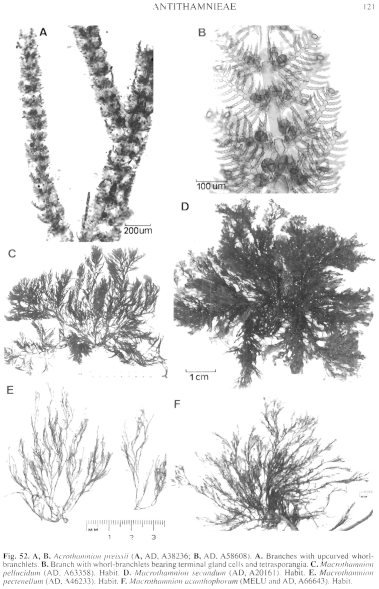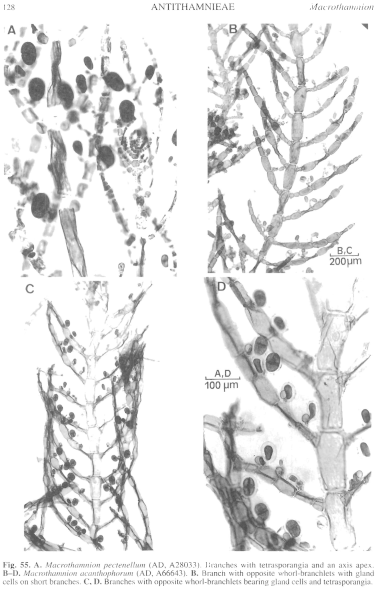|
|
|
|
|
|||||||||||
|
Electronic Flora of South Australia Species Fact Sheet
Phylum Rhodophyta – Order Ceramiales – Family Ceramiaceae – Tribe Antithamnieae
Synonyms
Callithamnion acanthophorum Kützing 1849: 647; 1861: 26, pl. 80a–c. Wollaston 1968: 329.
Callithamnion acanthocarpum (Kützing) Sonder 1853: 673. (Specific name misspelt.)
Thallus (Fig. 52F) medium red-brown, 2–10 (–16) cm high, much branched with numerous axes from a matted base, ecorticate, each axial cell with 2 opposite, distichous, whorl-branchlets (Fig. 55B–D). Attachment by rhizoidal filaments with terminal haptera; epiphytic. Structure. Apical cells 10–15 in diameter and L/D 1–2, enlarging rapidly, then to 200–300 µm in diameter and L/D 1–1.5 in lower axial cells. Whorl-branchlets 400–900 µm long, mostly simple (some with 1–3 adaxial pinnules), basal cells 25–60 µm in diameter and L/D 0.7–1, mid cells L/D 1.5–2.5, tapering to subterminal cells 18–25 µm in diameter and L/D 1–1.5, terminal cells mucronate; gland cells borne on short, 2–3-celled branches (Fig. 55B–D) on cells of whorl-branchlets, subspherical, 20–25 µm in diameter. Lateral branches arising from the basal cells of whorl-branchlets. Cells uninucleate; rhodoplasts elongate, becoming ribbon like in larger cells.
Reproduction: Gametophytes unknown. (MEL, 15323 has carposporophytes but is inadequate.)
Tetrasporangia occur on the special, short, gland cell-bearing branches (Fig. 55D) on cells of the whorl-branchlets, ovoid, 40–55 µm in diameter, decussately divided.
Type from Tasmania; in L, 938, 92... 345.
Selected specimens: Port Phillip Heads, Vic. (Wilson, 12.iv.1870; MEL, 15324, 19.i.1888; MEL 15326 and Jan. 1895; MEL, 15323, all as Wrangelia incurva), and 16–21 m and 17–21 m deep (on Caulerpa simpliciuscula), N of Quarantine Station (Kraft 10617, Saunders & Strachan, 5.iv.1995; MELU and AD, A66643, A67841). Georgetown, Tas. (Harvey, AIg. Aust. Exsicc. 546 I, in part).
Distribution: Port Phillip Heads, Vic., and N Tasmania.
Taxonomic notes: This little known species is characterised by opposite, simple, whorl-branchlets, distichously arranged, and is provisionally placed in Macrothamnion due to the similarity in habit, form of the whorl-branchlets, and small branchlets bearing gland cells and also tetrasporangia.
Harvey's A lg. Aust. Exsicc. 546 I, from Georgetown, Tasmania, includes both M. acanthophorum (AD, A18191) and M. pellucidum (AD, A18192).
Kützing (1849, p. 647) recorded the type specimen as parasitic on Carpacanthus oligophyllus, which Womersley (1987, p. 436) regarded as a synonym of Sargassum tristichum.
The nomen nudum Wrangelia incurva J. Agardh (see Wilson 1892, p. 170 and Gordon 1972, p. 39) was based on Wilson specimens (in MEL, e.g. 15324, 15326, 15327) from Port Phillip Heads, Vic. These are, at least mostly, M. acanthophorum; some are M. secundum.
References:
GORDON, E.M. (1972). Comparative morphology and taxonomy of the Wrangelieae, Sphondylothamnieae and Spermothamnieae (Ceramiaceae, Rhodophyta). Aust. J. Bot. suppl. 4, 1–180.
KÜTZING, F.T. (1849). Species Algarum. (Leipzig.)
KÜTZING, F.T. (1861). Tabulae Phycologicae. Vol. 11. (Nordhausen.)
SONDER, O.W. (1853). Plantae Muellerianae. Algae. Linnaea 25, 657–709.
WILSON, J.B. (1892). Catalogue of algae collected at or near Port Phillip Heads and Western Port. Proc. R. Soc. Vict. 4, 157–190.
WOLLASTON, E.M. (1968).Morphology and taxonomy of southern Australian genera of Crouanieae Schmitz (Ceramiaceae, Rhodophyta). Aust. J. Bot. 16, 217–417.
WOMERSLEY, H.B.S. (1987). The Marine Benthic Flora of Southern Australia. Part II. (Govt. Printer: Adelaide.)
The Marine Benthic Flora of Southern Australia Part IIIC complete list of references.
Publication:
Womersley, H.B.S. (24 December, 1998)
The Marine Benthic Flora of Southern Australia
Rhodophyta. Part IIIC. Ceramiales – Ceramiaceae, Dasyaceae
©State Herbarium of South Australia, Government of South Australia
Illustrations in Womersley Part IIIA, 1998: FIGS 52F, 55 B–D.

Figure 52 enlarge
Fig. 52. A, B. Acrothamnion preissii (A, AD, A38236; B, AD, A58608). A. Branches with upcurved whorl-branchlets. B. Branch with whorl-branchlets bearing terminal gland cells and tetrasporangia. C. Macrothamnion pellucidum (AD, A63358). Habit. D. Macrothamnion secundum (AD, A20161). Habit. E. Macrothamnion pectenellum (AD, A46233). Habit. F. Macrothamnion acanthophorum (MELU and AD, A66643). Habit.

Figure 55 enlarge
Fig. 55. A. Macrothamnion pectenellum (AD, A28033). Branches with tetrasporangia and an axis apex. B–D. Macrothamnion acanthophorum (AD, A66643). B. Branch with opposite whorl-branchlets with gland cells on short branches. C, D. Branches with opposite whorl-branchlets bearing gland cells and tetrasporangia.

|
Email Contact: State Herbarium of South Australia |

|